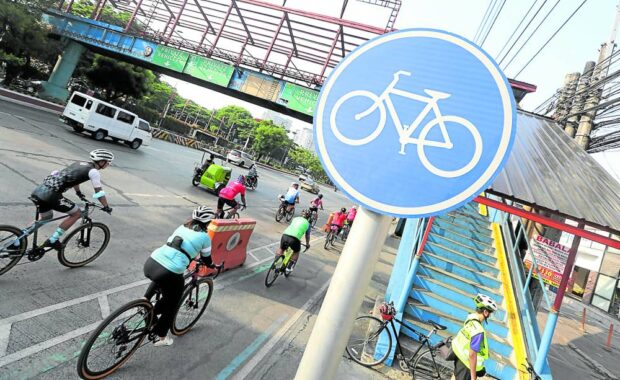Metro Manila mayors study bike system in Netherlands trip

‘AMSTERDAM’ ASPIRATIONS |Local chief executives needed a foreign trip to better see how Metro Manila and other urban centers can be more biker-friendly, hoping to apply what they have learned in places like Marikina City, which now have bike lanes in place. Photo taken on June 5, 2022.
(Photo by NIÑO JESUS ORBETA / Philippine Daily Inquirer)
MANILA, Philippines — Nine Metro Manila mayors and one vice mayor toured the Netherlands for three days last week to study, among others, the country’s best practices in their bicycle system and urban mobility that can be used in the Philippine setting.
Sponsored by the Metropolitan Manila Development Authority (MMDA), the trip also exposed the local officials to global benchmarks in waste management, waste-to-energy and flood control systems.
Joining the study tour were Mayors Ruffy Biazon of Muntinlupa; Imelda Calixto-Rubiano of Pasay; Quezon City’s Joy Belmonte; Jeannie Sandoval of Malabon; Weslie Gatchalian of Valenzuela; San Juan City’s Francis Zamora; John Reynald Tiangco of Navotas; Miguel Ponce III of Pateros; and Caloocan’s Dale Gonzalo Malapitan. The lone vice mayor in the group was Carmelita Abalos of Mandaluyong.
The delegates were welcomed by Amsterdam City officials on April 18 and on the third day were brought to the Stationsplein underwater bicycle parking facility, which has two-layer bike racks, free of charge for the first 24 hours, and connected to the city’s train and tram lines in the capital city of Amsterdam.
For replication
The Stationsplein facility opened in January this year and is the biggest bicycle parking facility in Amsterdam that can store about 7,000 bicycles. Built under the river in front of the Amsterdam Central Train Station, it aims to reduce the number of bikes parked on the street and allow travelers to walk to and from the public transport system.
Article continues after this advertisementBiazon said he was looking to replicate these projects on a smaller scale even though there were not as many bikers in his city.
Article continues after this advertisement“I do not see that we will reach (Amsterdam’s) percentage of population who are using bikes every day, so we do not need such big facilities,” Biazon noted.
In Quezon City, Mayor Belmonte assured the public that the city would remain biker- and pedestrian-friendly by promoting biking as an alternative means of transportation to its citizens.
“We have a safe 93-kilometer bike lane network with assigned bike patrollers who will assist cyclists. There are also bike ramps provided by the city government in the 40 footbridges and underpasses for a better biking experience in Quezon City,” she said.
Available online
While the mayors’ efforts to learn abroad were appreciated, Keisha Mayuga, an MBA student in Sustainable Mobility at the Technische Universität Berlin, asked “what will happen with those learnings to really know the value of the study trip.”
“The Embassy of the Netherlands in the Philippines has been giving many opportunities for learning through online means (webinars, training, etc.) throughout recent years, but only a few cities, agencies and organizations have put something real on the ground,” Mayuga pointed out.
Mayuga also noted that Metro Manila mayors could learn foreign principles and concepts that they could consider in the Philippine setting instead of replicating their practices.
Meanwhile, Ian Braga, a local biker in Metro Manila, challenged the mayors to personally experience the transportation system in the country to better understand its unique challenges, rather than go abroad and learn other countries’ practices.
“I’d ask for these politicians to walk and/or ride with daily commuters who deal with the realities of their policies and infra—not just weekend recreational sports riders who seem to be the inaccurate default,” Braga noted.
Pandemic transport
Biking as a means of transportation spiked in Metro Manila due to the coronavirus pandemic, which sidelined public transportation to keep people in their homes to avoid the spread of the virus, exposing in the process the need for better road infrastructure that moves people and not cars.
According to a 2021 survey by MNL Moves, an advocacy group encouraging people to walk and cycle in Metro Manila, around 40 thousand cyclists use the roads daily, occupying 105.12 square kilometers of road space or about 6,256 people in cars.